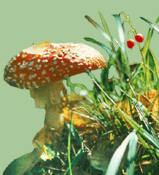he Antarctic for Estonia.
Marju Erit looks at management of seminatural communities at the Silma Nature Protection Area.
Fungi against fungi
Märt Hanso and Tiia Drenkhan introduce the fungus Phlebiopsis gigantea, which is effectively used to fight Heterobasidion, a fungus that causes infection on hundreds of thousands of trees every year. Rotstop, a biological formulation based on Phlebiopsis gigantea that grows also in our forests, has proved to be the most efficient biological method of control.
The global warming may bring about global cooling
Siim Veski, getting support from the research of lake mud, claims that the warming climate may bring about an unbelievable future scenario global cooling. He looks back at history, searching for reasons and links between warmer and cooler periods. A large-scale cooling took place in Europe about 8200 years ago, and the traces of the cooling can be seen also in the lake mud of Lake Tõugjärv at Rõuge.
Essay: Black or white by Mait Sepp
The Peetri River Landscape Protection Area
Uudo Timm takes the reader to vicinity of the Latvian border: to the South-Estonian limestone and sandstone denudations and fresh boreo-nemoral forests. If you are lucky, you can also see the extremely rare Roller here.
European rarities in Estonia: Salmon
Kunnar Klaas, Herki Tuus and Tiit Paaver describe the most wanted, but also a rather endangered fish of our waters the salmon (Salmo salar). The article includes the biology of the species as well as issues of fish-farming and protection of salmon.
Interview: Toomas Jüriado has interviewed Kalev Sepp, professor of Estonian Agricultural University and the new regional councillor of the IUCN.
Walk on the southern track of the mysterious Naissaare Island
Birgit Itse helps to get to know an island located so close to Tallinn, yet a white spot for many people. On the 13 km-long southern track, you can encounter some holy places and breath-taking views as well as a former mine storage.
The bogs of the oil-shale country grow into forest
Marko Kaasik and Tõnu Ploompuu write about the impact of alkaline oil-shale fly ash on the raised bogs of North-East Estonia: the Sphagnum moss disappears and peat stops growing, and therefore thousands of tons of carbon dioxide remain in the atmosphere. Although one could rejoice over the good growth of forest, the amount of peat we lose is bigger that the hypothetical benefits from more timber.
From primary outlines to modern navigation maps
Vaido Kraav and Tõnis Siilanarusk recall the history of mapping Estonian marine territory and take us also to nowadays world of modern digital maps and information systems.
| 

![[IN ENGLISH]](images/gb.gif)





